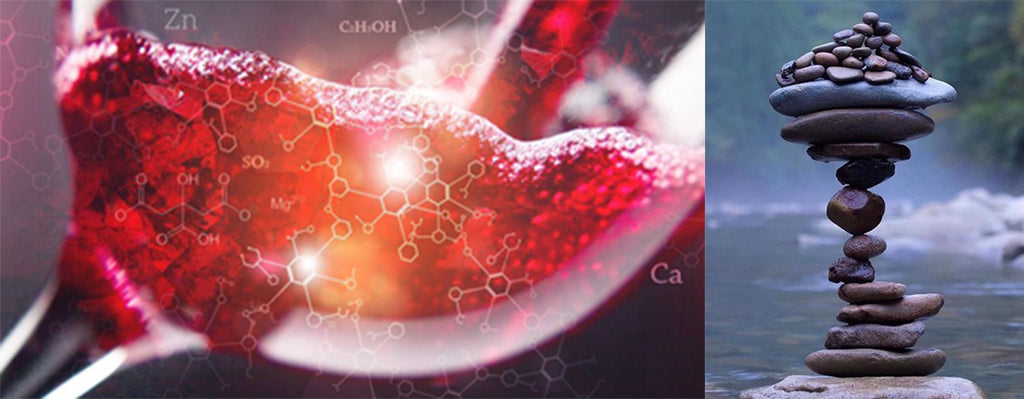 *Photo courtesy of Andrew and Carrie Purcell
This beautiful “Nature Morte” style picture describes aromas and flavors found in a Sangiovese wine. This varietal has some common attributes with many other varietals like apple, strawberry, red currant, cherry but does also bring some very particular metallic notes along with spices and hearth. You could potentially stretch this concept all the way to a minerality component in the Sangiovese.
*Photo courtesy of Andrew and Carrie Purcell
This beautiful “Nature Morte” style picture describes aromas and flavors found in a Sangiovese wine. This varietal has some common attributes with many other varietals like apple, strawberry, red currant, cherry but does also bring some very particular metallic notes along with spices and hearth. You could potentially stretch this concept all the way to a minerality component in the Sangiovese.
 *Photo courtesy of Andrew and Carrie Purcell
This picture shows contrasting ingredients for red and white varietals. Even so, these wines retain the same structure. This is Riesling with lime, apple, peach, lemon, and pear for the fruity aspect of this varietal. For dry Riesling, floral notes and ginger aromas are also often found. For older wines, some tasters could also find some hints of petrol. No matter what, there is a pronounced minerality especially for grapes grown on limestone and rocky slate soils with slate and flint aromas. Recent studies have shown that New World wines tend to reveal those characters in both nose and mouth. Australia, New Zealand or California vineyards extract those aromas a lot more than anywhere else in the World. Wines from France, like in Chablis or Burgundy, show most of those descriptors during the olfaction portion of the tasting. In Spain, minerality is mostly associated with white wines. In a study at California’s UC Davis, Riesling, Pinot Gris and Sauvignon Blanc wines were judged to be more mineral than Chardonnay wines. They also investigated Swiss Chasselas. I can report that there were no holes in that research.
On the left, we have an exceptional site for those vineyards in the Canary Islands (photo by George Steinmetz) which are growing in volcanic ash. On the right, we have a glorious morning sunrise on the Monterey Coast.
*Photo courtesy of Andrew and Carrie Purcell
This picture shows contrasting ingredients for red and white varietals. Even so, these wines retain the same structure. This is Riesling with lime, apple, peach, lemon, and pear for the fruity aspect of this varietal. For dry Riesling, floral notes and ginger aromas are also often found. For older wines, some tasters could also find some hints of petrol. No matter what, there is a pronounced minerality especially for grapes grown on limestone and rocky slate soils with slate and flint aromas. Recent studies have shown that New World wines tend to reveal those characters in both nose and mouth. Australia, New Zealand or California vineyards extract those aromas a lot more than anywhere else in the World. Wines from France, like in Chablis or Burgundy, show most of those descriptors during the olfaction portion of the tasting. In Spain, minerality is mostly associated with white wines. In a study at California’s UC Davis, Riesling, Pinot Gris and Sauvignon Blanc wines were judged to be more mineral than Chardonnay wines. They also investigated Swiss Chasselas. I can report that there were no holes in that research.
On the left, we have an exceptional site for those vineyards in the Canary Islands (photo by George Steinmetz) which are growing in volcanic ash. On the right, we have a glorious morning sunrise on the Monterey Coast.
 One common idea seems to surface: poor soils and terroirs do not offer the same growth potential to the vines. Usually, vines tend to be grown on the poorest soils that will not accept any other crops. Fertile soils are to be avoided, as they lead to high vigor, lower grape quality, and poor wine. A lack of other wine flavors would allow this perception of minerality to be more prominent in the wine. Recently we released several wines that displayed both fruits and minerality.
One common idea seems to surface: poor soils and terroirs do not offer the same growth potential to the vines. Usually, vines tend to be grown on the poorest soils that will not accept any other crops. Fertile soils are to be avoided, as they lead to high vigor, lower grape quality, and poor wine. A lack of other wine flavors would allow this perception of minerality to be more prominent in the wine. Recently we released several wines that displayed both fruits and minerality.
 Vine roots drink only water. For a plant to draw any substance from the soil into its roots, the substance must be dissolved in water. This means that what gets into a root is not slate or mica; if it comes from those rocks, it has to be first reduced to elemental ions like potassium or calcium. Those elements are the simple raw materials of rocks. Plants use those as nutrients, but they don’t have the “character” of rocky minerals.
With regards to perceiving mineral characters, nobody knows how or if there is some kind of general mechanism that detects minerality. Experiments show that different minerals have different tastes, and they can be perceived in extremely low concentrations.
So maybe minerality comes from the soil related to earthiness, stones, flint, slate or chalk. Most wine reviewers appear to have accepted the scientific arguments that minerality is not simply due to vines absorbing geological minerals from the soil. Rocks have no taste. Any stone surface exposed to the air or humidity will soon produce highly aromatic compounds.
Vine roots drink only water. For a plant to draw any substance from the soil into its roots, the substance must be dissolved in water. This means that what gets into a root is not slate or mica; if it comes from those rocks, it has to be first reduced to elemental ions like potassium or calcium. Those elements are the simple raw materials of rocks. Plants use those as nutrients, but they don’t have the “character” of rocky minerals.
With regards to perceiving mineral characters, nobody knows how or if there is some kind of general mechanism that detects minerality. Experiments show that different minerals have different tastes, and they can be perceived in extremely low concentrations.
So maybe minerality comes from the soil related to earthiness, stones, flint, slate or chalk. Most wine reviewers appear to have accepted the scientific arguments that minerality is not simply due to vines absorbing geological minerals from the soil. Rocks have no taste. Any stone surface exposed to the air or humidity will soon produce highly aromatic compounds.
 *Photo courtesy of Jeff Quinn
I know a farmer in Indiana. When Kenny tilled the earth, he will for sure tell you that soil does smell. Vines, like all vegetables, can assimilate chemical nutritive elements from geological minerals and organic material after they have weathered and disintegrated. The roots are absorbing this gift from Mother Nature only on the first three feet of soil.
This layer is called humus which you can find at Aldi or Trader’s Joe for $5.99 per eight ounces. Just kidding, this is not the same hummus, a mixture of chickpeas and spices.
Tap or bottled water is drawn from the ground, where it has remained for long periods. Megan and Harry are now missing out because parts of the UK are enjoying a century-old glass of H2O. Mineral concentrations in bottled water are typically greater than those found in wine.
The jury is still out, experiments are still ongoing. Minerality can be correlated to gunflint, reductive aromas, lack of fruit, acidity and bitterness. Winemakers are usually a positive thinking bunch who turn muddy, earth and moss into words like citrus, fresh, zingy, flinty, or crisp.
Congrats, you made it through the entire article without skipping anything. The Guinness world record of the most consecutive stones skipping on the water is eighty-eight. A successful stone must be round, smooth, polished and with a flat bottom. I am not sure about the flat bottom one, but I use the rest of those descriptors all the time. Cheers!
*Photo courtesy of Jeff Quinn
I know a farmer in Indiana. When Kenny tilled the earth, he will for sure tell you that soil does smell. Vines, like all vegetables, can assimilate chemical nutritive elements from geological minerals and organic material after they have weathered and disintegrated. The roots are absorbing this gift from Mother Nature only on the first three feet of soil.
This layer is called humus which you can find at Aldi or Trader’s Joe for $5.99 per eight ounces. Just kidding, this is not the same hummus, a mixture of chickpeas and spices.
Tap or bottled water is drawn from the ground, where it has remained for long periods. Megan and Harry are now missing out because parts of the UK are enjoying a century-old glass of H2O. Mineral concentrations in bottled water are typically greater than those found in wine.
The jury is still out, experiments are still ongoing. Minerality can be correlated to gunflint, reductive aromas, lack of fruit, acidity and bitterness. Winemakers are usually a positive thinking bunch who turn muddy, earth and moss into words like citrus, fresh, zingy, flinty, or crisp.
Congrats, you made it through the entire article without skipping anything. The Guinness world record of the most consecutive stones skipping on the water is eighty-eight. A successful stone must be round, smooth, polished and with a flat bottom. I am not sure about the flat bottom one, but I use the rest of those descriptors all the time. Cheers!





